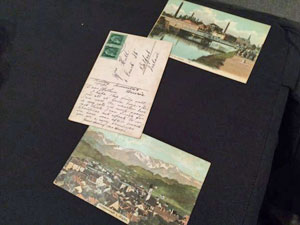Bangor Historical Society held its final meeting of the 2016-2017 season on 13 April. The meeting began with the AGM. The chairman, Ian Wilson, thanked the committee and officers of the society, including the secretary, Ronnie McClements, and the treasurer, Adrianne Brown, as well as the other helpers, including Linda Patterson who organises the tea. The existing committee was re-elected.
 Leanne Briggs of the North Down Museum gave the Bangor Night talk on the Museumís postcard collection. It contains over 3,000 pictures which are currently being digitised. She showed a selection of those on Bangor and talked about them. Bangor Bay was a popular subject.
Leanne Briggs of the North Down Museum gave the Bangor Night talk on the Museumís postcard collection. It contains over 3,000 pictures which are currently being digitised. She showed a selection of those on Bangor and talked about them. Bangor Bay was a popular subject.
Some of the early postcards incorporated a crest which was actually that of Bangor in North Wales. A postcard of c1911 showed the steamer or Bangor boat, the esplanade and lower Main Street. A later picture of 1970 showed the Big or Long Hole and the McKee Clock area Ė all before the marina was created. The collection also includes typical amusing seaside scenes, which were used for many resorts, the name of the place being added as appropriate.
The Marine Gardens and the area around Stricklandís Glen were also popular subjects. Scenes included the Homes of Rest and the Bungalow, the tea room at the Glen. An early picture of the steamboat, included the gentlemanís bathing place at Pickie in the foreground. The ladiesí bathing place at Skippingstone appeared on another card. The amphitheatre around Marine Gardens was pictured around 1910 with Glenbank in the background. This area was the scene of an anti-home rule rally in 1912.
In one early card a dog had been painted onto a scene of people walking past Pickie. These views were contrasted with a modern picture of Pickie with its swans. The bandstand appeared in another view of Marine Gardens. This is now in the Walled Garden.
In the early twentieth century pierrots performed at Bangor during the summer season. One postcard showed the Palace Pierrots on stage at the esplanade. Leanne also referred to the messages on the cards. She explained that they arrived very quickly, perhaps even the same day so that people could use them to request things as people today might use a text message.
The childrenís corner was a sandy area at the foot of Main Street. Sand castle competitions were held there. In the background was Barryís amusements.
The Long Hole was called Clifden in another card. There is a story that the stone for the wall around Bangor Castle was excavated here and so created the little harbour. Further round Seacliff Road the Royal Ulster Yacht Club house was pictured with an early version of Caproniís alongside. The latter was housed in a shedlike building.
Ballyholme was also a popular site for pictures. One early postcard showed the beach and the windmill in the distance. Another subject of 1946 was the donkeys on the beach.
Pictures of Ward Park included the pond and the library. Finally there were scenes from the Clandeboye estate, showing soldiers and the World War One camp.
